Background
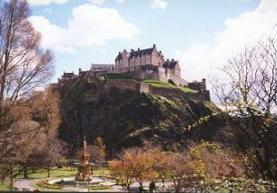
Edinburgh's Royal Mile (it is actually one mile and 107 yards from entrance to Edinburgh Castle to the gates of the Palace of Holyrood House) is not only a popular tourist attraction but also provides a fascinating insight into the history of the City and of Scotland itself. It was described by Daniel Defoe as the "Largest, Longest and Finest Street in the World"
Edinburgh Castle sits on top of what was, at one time, a volcano. It has been used as a fortification for over 2,000 years - there was a hill fort there in the time of the Romans. What is now Princes Street Gardens was originally a loch - the Nor' Loch - which added to the defences of the rock.

Easy to miss is the "Witches Well" on the eastern corner of the esplanade of Edinburgh Castle, which marks the spot where, over a time span of 250 years, 300 women accused of witchcraft, were burned to death. In the 17th and 18th centuries Scotland put to death over 4,000 alleged witches. Indeed, Scotland is estimated to have been Europe's biggest persecutor of witches. By the end of the 17th century burning had gone out of fashion so most of them were hanged instead. The last hanging took place in 1728.
The Royal Mile runs east down the shoulder of the hill from the castle. The shoulder itself was formed when the whole of Scotland was covered by an ice sheet and the flow of the glacier ran from west to east - dropping rubble and earth in the lee of the rock. The castle esplanade (the location for the annual Edinburgh Military Tattoo) leads to the Royal Mile itself. The Royal Mile consists of a number of connected streets, starting at Edinburgh Castle and its esplanade, and runs downhill from west to east, starting with Castlehill, followed by
- Lawnmarket
- High Street and Parliament Square
- Canongate and Abbey Strand
There is a collection of my video clips from the Royal Mile on YouTube which may give you an overview of the Royal Mile before reading the descriptions of the main places of interest to tourists below.
Castlehill
The first building on the right as you leave the esplanade is the so-called "Cannonball House". If you look carefully, you can see a cannonball embedded in its wall. There are various stories about how it got there - including one claiming that the gunners at Edinburgh Castle were trying to fire a cannonball from the castle (in government hands) hoping to reach the Palace of Holyroodhouse when Bonnie Prince Charlie was in residence there during the 1745 Jacobite Uprising!

To the left of Castlehill is Ramsay Gardens. The present buildings go back to a redevelopment in the 18th century. Since there were no official planning controls in those days, there is a delightful mix of architectural styles, including an octagonal "Goose-pie" house built by Allan Ramsay the poet. There is a beautiful spacious flat, with a panoramic 360 degree view, designed by Sir Patrick Geddes (regarded as the "father" of town planning) which was created to encourage the University professors to return to the "Old Town" of Edinburgh.

The Camera Obscura on Castlehill houses mirrors that project an image of the surrounding area on a screen - in this case, Princes Street and the gardens below the castle. The original building contained a Camera Obscura as far back as the middle of the 19th century and continues to entertain visitors with views of Princes Street below. Perhaps in today's world of video cameras this not perhaps as impressive as it must have been 150 years ago. Currently the building also houses "World of Illusions" with exhibits to do with light, illusion and the way we see the world. Definitely worth a visit when the weather outside is wet!
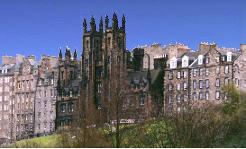
The Free Church of Scotland College and Assembly Halls on Bank Street, overlooking Princes Street Gardens, extend all the way back to the Royal Mile, down a considerable length of Castlehill. The Assembly Halls, with its skyline of towers and turrets was built as "recently" as the latter half of the 19th century, designed by the architect William Henry Playfair. The Assembly Halls leapt to prominence in 1998 because they were selected as the temporary home of the new Scottish Parliament until the permanent building was constructed at the other end of the Royal Mile at Holyrood.

Almost opposite the rear of the church Assembly Halls is the "Scotch Whisky Experience" in what used to be Castlehill School. It has been created to celebrate Scotland's "national drink" and tell the history of the product and how it is made. A major element is an hour-long ride (in a whisky barrel, no less) during which the sounds, smells and the story of whisky is told involving life-like figures - including a resident ghost who used to be a master blender. The building also displays the a collection of 3384 whiskies built up over 35 years by Brazilian connoisseur Claive Vidiz -setting the world record for the largest collection of Scottish whiskies. If you want to start your own collection, the shop has over 300 malt whiskies on sale!

The last building on Castlehill is now "The Hub". Its gothic spire is the highest point in central Edinburgh, higher even than the top of the castle, further up the hill. It was originally built for the Church of Scotland both as a parish church and as a purpose-built General Assembly Hall. Constructed between 1842 and 1845, it was originally known as the Victoria Hall. The General Assembly of the Church of Scotland last met there in 1929, when the Church of Scotland united with the United Free Church of Scotland, thereafter using the former United Free Church's Assembly Hall on The Mound (see above). The building was closed in 1979 and was unused for a number of years. Then in 1999 the building was transformed into "The Hub", with the offices and a performance space for the Edinburgh International Festival. It now houses the Hub Cafe and Hub Tickets, the central box office for the International Festival as well as providing spectacular space for a variety of events, including conferences, banquets, weddings and exhibitions in a building that combines award winning contemporary design and classic Victorian architecture.
Lawnmarket

Just into Lawnmarket after leaving Castlehill is a bar named after "Ensign Ewart". Ewart was a Scottish soldier of the Royal North British Dragoons (more commonly known as the Scots Greys), famous for capturing the regimental eagle of the 45e Régiment de Ligne (45th Regiment of the Line) at the Battle of Waterloo. His actions made him a hero and he was later buried under a statue on Edinburgh Castle esplanade. The eagle badge of the Royal Scots Greys regiment was derived from this incident.

There are many "closes" or alleyways running off the Royal Mile in Edinburgh. They often contain substantial houses, such as this one which was built in 1622 for a William Grey of Pittendrum who had the words "Feare The Lord and Depart From Evil" carved above the door along with his initials and those of his wife. William Grey installed an early form of burglar defence in his house - the height of each of the main steps differs, making it difficult to run up and down them! The building was later bought by Lady Stair in 1719 and the building now bears her name. The exterior of the building was much modified in the 19th century with a balconied tower and other stonework being added. The building is now occupied by a "Writers' Museum" dedicated to Robert Burns (who stayed in a house opposite during his first visit to Edinburgh in 1786), Sir Walter Scott and Robert Louis Stevenson.

As noted above, Lady Stair's House now belongs to the City of Edinburgh and has been turned into a Writers' Museum dedicated to three of Scotland's most famous writers - Robert Burns (who stayed in a house opposite during his first visit to Edinburgh in 1786), Sir Walter Scott and Robert Louis Stevenson. It is crammed with pictures, etchings, busts and memorabilia of the three writers, including bibles, pipes and walking sticks. From time to time the Museum runs special exhibitions on one of the three writers. Regrettably, you are not allowed to take photographs inside the Museum.

Gladstone Land was bought and extended by a Thomas Gledstanes in 1617 (though it had originally been built in the previous century) and was a typical house of its time. In 1934 it was condemned and was about to be pulled down but was rescued by the National Trust for Scotland who have restored it to illustrate what life was like in the 17th century with open fires, no running water but packed full of furniture of the period. During restoration, painted ceilings were uncovered and the arcade frontage providing shelter for the customers (typical of the shop frontages popular in the 17th century) has been restored. Typical of Edinburgh buildings of its day, it rises to six stories. Various floors in the building would have been rented out by Thomas Gledstones. "Gled" is the Scots word for a hawk, which explains the (modern) hanging sign outside the building which has the date 1617 surmounted by a gilt-copper hawk with outstretched wings

Inevitably there are many, many souvenir ships on the Royal Mile, selling low priced clothing (including what are described as "kilts" but which are far removed the ones you would find at Highland Games or hired out in a gents outfitters for wearing at a wedding!) The shops are often dismissed as "Tartan Tat", especially when they blare out loud Scottish music to attract the customers. But they stock whatever sells well on the street - or go out of business. The one pictured here "Thistle Do Nicely" actually closed down a few years ago but many have stood the test of time and the Royal Mile would be a duller place without them!
High Street and Parliament Square

Just past Bank Street, the section of the Royal Mile named "High Street" begins, marked near the corner by a statue of philosopher David Hume. Hume was born in Edinburgh in 1711 and entered Edinburgh University at the age of 12 to study law, leaving less than three years later, having concentrated more on his own interests than his course work. His development of philosophical ideas had been influenced by the concepts of science and observation but his first major book "A Treatise of Human Nature" in 1739 was not an immediate success. His next book "Essays, Moral and Political" in 1741 was more successful but at a time when religious dogma was followed by most people without question, he was a self-proclaimed atheist. He was thus not able to become professor of philosophy at Edinburgh University because of his "anti-religious" views. While in Paris (as Secretary to the British Embassy from 1763-66) he became popular with French society and helped the writer Rousseau. Hume returned to Edinburgh and mixed with the intellectuals of the capital during the phase described as "The Scottish Enlightenment". His associates included the economist Adam Smith, the portraitist and essayist Allan Ramsay and the historian William Robertson. A recent poll of academics voted Hume as the Scot who had made the greatest impact on Scotland in the last 1,000 years.
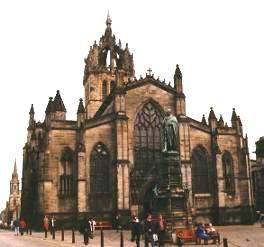
Early in his reign, King David (1124-1153) granted responsibility for a parish church at St Giles (the Patron Saint of Edinburgh) to the Lazarites, a religious order dedicated to helping lepers. St Giles is regarded as the patron saint of lepers. This church was burned down by the English in 1385. Much of the present building dates from 1829 but the famous crowned steeple dates from 1495 - extensions have been added over the centuries. John Knox was minister in St Giles 1559 and as a result of the Reformation, the last mass to be sung in the "High Kirk of St Giles" was in 1560. In 1637, when the Bishop of Edinburgh attempted to read a newly-introduced English Liturgy, legend has it that Jenny Geddes, a vegetable seller, threw a stool at the preacher who dared to "sing masse in ma lug" (ear). The most recent extension was in 1911 when the knights of the Thistle, Scotland's highest order of chivalry, built a chapel dedicated to the Order.
Across from St Giles was the original location of the Scottish Parliament, built here in 1641 and giving the Square its name. It ceased having that role in 1707 with the Union of the Scottish and English Parliaments. The present Scottish Parliament building is now at the far end of the Royal Mile, opposite the Palace of Holyroodhouse.

Just beyond St Giles is the "Mercat Cross", central meeting place where Royal proclamations and other official announcements were read out. The original mercat cross has been replaced by one in 1885 though that does include a part of the original one. Beyond that is a relatively new statue of Adam Smith. Adam Smith was raised in Kirkcaldy. After attending grammar school there, Smith went to Glasgow University - at the age of 14 - to study maths plus natural and moral philosophy, afterwards going on to study at Oxford for seven years. He returned to Scotland and did some lecturing at Edinburgh University. This was so successful that he was appointed to the Chair of Logic at Glasgow University at the age of 28. He became professor of moral philosophy in the following year. Following a spell in Paris between 1764 and 1766 (where he met Voltaire and other philosophers) he returned to Kirkcaldy and spent the next ten years writing his great work "An Inquiry into the Nature and Causes of the Wealth of Nations" which was published in 1776. This was not only the first "modern" book on economics, it also advocated free trade as the way to increase wealth and as such, it was extremely influential. It was written in a clear, understandable style and had considerable influence on William Pitt the Younger who became Prime Minister in 1784. Smith was elected Lord Rector of Glasgow University in 1787.
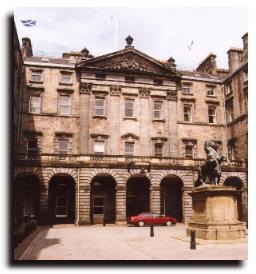
The City Chambers (roughly the "Town Hall"), now the home of Edinburgh City Council, were designed by John Adam (the eldest of the Adam brothers) as a Royal Exchange and Customs House. They were built in 1753-61 on top of an existing street - Mary King's Close - which now forms the basement (and a tourist attraction). At the rear of the building, it towers 12 storeys above Cockburn Street. The statue in the forecourt is of Alexander the Great taming his rampant horse Bucephalus. Quite what that has to do with the City Council is hard to fathom!
Mary King's Close was a 17th century street in the old city of Edinburgh. Much of the Close is still intact and in its original state. Shops and houses can be inspected - and some ghostly figures have been experienced over the years in this 'Street of Sorrows.' It runs from the High Street northwards underneath the present City Chambers (pictured here). Before the building of Cockburn Street, the close had continued down to Market Street where the north most exit is marked, these days, by the Hebrides Bar!

At the junction of High Street with South Bridge, at Hunter Square, is the Tron Kirk. It gets its name from the salt-tron, a public weighing beam which used to be located outside the church. It was founded in 1637 when King Charles I tried to impose an Episcopal style on the Presbyterian Church of Scotland, including making St Giles into a cathedral. The congregation built a new church instead, just down the Royal Mile from St Giles. It originally had a wooden spire but that burned down in 1824 and was replaced in stone a few years later.
The Tron Kirk closed as a church in 1952 and the building now houses an exhibition on the history of the Royal Mile. This is enhanced by the remains of the 16th century Marlin's Wind which were excavated in 1974 and the stones of the old street have been left visible within the Tron Kirk.

The rear of this old house dates back to not long after 1450, replacing an earlier wooden construction. The frontage was added around 1472 and subsequent additions, floors and modifications have been made ever since. James Mossman, who was a goldsmith and keeper of the Royal Mint to Mary, Queen of Scots, was responsible for a substantial reconstruction.
Although John Knox, the great reformer of the church in Scotland, lived at this time, there is no record of him ever staying in this house. But, over the years, the legend evolved that he had given one of his thundering orations to the people of Edinburgh from a bow-window on the house, overlooking the High Street. By 1800 it was confidently being described as "John Knox's House" and guide books ever since have described it in this fashion. The house is now a museum, concentrating on Knox and his influence and as such is a popular tourist attraction.
Canongate and Abbey Strand

The original Canongate Tolbooth was built around 1590 in a Franco-Scottish style. This was the centre of the burgh of Canongate, at the lower end of the Royal Mile where road tolls or public dues were collected. The entrance to the Council Chamber was by an external stair as the ground floor was the local prison.
The building was rebuilt on a different site in 1879 and it now houses the "People's Story Museum". This illustrates life of ordinary people in Edinburgh over the last 200 years. The clock on the outside of the building is a replacement for one made in the 17th century.
The Latin inscription on the front of the building reads:
The place of the seal of the Burgh.
For one's country and one's successors, 1591.
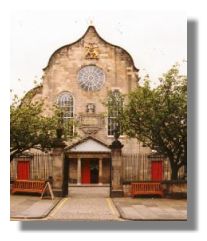
The residents of Canongate originally worshiped at Holyrood Abbey but Canongate Church (illustrated here) was built for them in 1688 - by the Catholic-leaning King James Vl after he turned Holyrood into a Chapel Royal for use by the Knights of the Thistle. After the Battle of Prestonpans in 1745, Prince Charles Edward Stuart's prisoners were confined here. The churchyard contains the graves of a number of famous people including Adam Smith (author of "The Wealth of Nations"), Mrs Agnes McLehose ('Clarinda' of Robert Burns), James Gregory (inventor of "Gregory's Mixture" - a purgative!) and the poet Robert Fergusson. Burns was influenced by Fergusson and wrote of him - "Rhyme I had given up, but meeting with Fergusson's Scotch poems I strung my wildly-sounding rustic lyre with emulating vigour". Burns paid for a gravestone for Fergusson (who died at age 24) which is inscribed:
- No storied urn nor animated bust
- This simple stone directs pale Scotia's way
- To pour her sorrows o'er her Poet's dust
- This simple stone directs pale Scotia's way
No sculptured marble here nor pompous lay
There is now a fine statue of Fergusson on the pavement outside the church, striding purposefully down Canongate.

The Museum of Edinburgh is said to be the City's "treasure box" with a maze of historic rooms crammed full of iconic objects from the Capital's past including curiosities like Greyfriars Bobby’s collar and bowl and John Knox’s spectacles case. For many years the building was dowdy and easily missed. But after 80 years of being almost ignored, in 2012 it had an £800,000 makeover and now you can hardly miss the bright ochre walls and the pillarbox red woodwork. The museum claims that these are colours that they would have been painted in the past. Many of Edinburgh’s buildings were painted all sorts of hues over the years, and ochre was a very traditional colour.
Inside the rabbit warren of rooms have walls that are just as vibrant as the exterior and the roof beams have been painted with golden transcriptions of Latin sayings such as “Today to me, tomorrow to thee” as well as the cries of Royal Mile tradesmen of the distant past such as “Hot mutton pies”, “oysters and herrings, three a penny”, “razors, knives and shears to grind”. There is a presentation area screening a video vox pop of people telling why Edinburgh is important to them. And in a darkened room, a huge screen is embedded in the floor. From here you are told the story of Edinburgh in just 15 minutes. Much of the upper floors of the museum, however, are still to be renovated and brought up to these modern standards - but are nevertheless packed with fascinating artefacts from Edinburgh's illustrious past.

Queensberry House is a 17th century Category A listed building in the Canongate, Edinburgh, Scotland, incorporated into the Scottish Parliament complex. It contains the office of the Presiding Officer, two Deputy Presiding Officers, the Parliament's Chief Executive, and other staff. The mansion house was built in around 1667 but was bought by William Douglas, 1st Duke of Queensberry around 1689. The most famous resident is probably James Douglas, 2nd Duke of Queensberry who was influential in setting up the Treaty of Union in 1707. From 1803 to 1996 the building was used as a hospital.
When it was decided that the new Scottish Parliament building should be created on the site of a former brewery at the foot of Canongate (opposite the historic Palace of Holyroodhouse) it was initially proposed that Queensberry House should be demolished. But Historic Scotland insisted that it should be retained and so it was - significantly adding to the already soaring cost of the Parliament building! Increased awareness of potential terrorist threats has resulted in high ugly railings being incorporated as security fences.

As the Presiding Officer (Speaker) of the reconstituted Scottish Parliament put it when it opened on 12 May 1999, "The Scottish Parliament, adjourned on 25th March 1707, is hereby reconvened." Initially, the parliament met in temporary accommodation provided by the Church of Scotland Assembly Hall on the Mound, overlooking Princes Street Gardens. Demolition work on the site for the new building had started in October 1998 and the Members of the Scottish Parliament (MSP's) finally moved in by the end of September 2004, having spent over £400 million to finish the project.
Whenever anyone writes about the Scottish Parliament Building, the word "controversial" is usually included somewhere. Enric Miralles, the Spanish-born main architect, considered the parliament "not as a single building - it is an orchestrated series of constructions", which he linked through the impressive central members' lobby with its pillars and sweeping roof lights. Miralles, (who died during the course of the project) said that he imagined a parliament should be organised like a university campus designed for different places for thinking talking and walking. The public entrance hall, which is located below the debating chamber, has a curved concrete roof that is reminiscent of the "barrel vaulted" roofs in many Scottish castles. The Saltire symbol is carved into the roof - a reminder too that the area in which the building is located is called "Holyrood" or Holy Cross. The wall on the Canongate side of the building (seen in the illustration here) is inset with different Scottish stones; some contain ancient fossils and others have quotations submitted from members of the public. For example, one proverb reminds the elected members in a mixture of Gaelic and English to "Say but little but say it well."
For more on visiting the Scottish Parliament and its architecture, see Scottish Parliament Inside and Out elsewhere on this site. This includes links to a slide show on YouTube from a selection of graphics taken from the outside of the building, plus pictures taken in the public areas during my visit, as well as graphics from the Scottish Parliament site itself of internal rooms such as the committee rooms and the members' lobby and offices where photography is not allowed.

Edinburgh grew as a merchant city and was crammed with buildings long before Kings and Queens could make their mark on the city (other than in the castle). Many other locations around Scotland housed the capital before Edinburgh. So the Royal Palace of Holyroodhouse had to be built outside the city walls beside an earlier Abbey of the Holy Rood (Holy Cross) at the foot of the Royal Mile. It was started in 1501-1505 by James IV (who was King of Scotland 1488-1513 and defeated at Flodden in 1513) and was added to by James V and Charles II. The murder of Mary Queen of Scots' secretary, Rizzio, took place in the Palace as did her marriage to Lord Darnley. After King James VI left Scotland for London after the Union of the Crowns in 1603 its importance diminished. It had to be extensively repaired when George IV visited Edinburgh in 1822 but it only regained its status as a Royal Palace when Queen Victoria became a regular visitor in the 19th century. The Palace is now the official residence in Scotland of Queen Elizabeth II. The ruins of Holyrood Abbey are all that remain standing beside the Palace.



